Ricoh Shotmaster ultra zoom
This camera manual library is for reference
and historical purposes, all rights reserved.
This page is copyright
© by

M. Butkus, NJ.
This page may not be sold or distributed without the
expressed permission of the producer.
I have no connection with any camera company.
On-line camera manual library.
Back to main on-line manual page
If you find this manual
useful,
how about a donation of $3 to:
M. Butkus, 29 Lake Ave.,
High Bridge, NJ 08829-1701
and send your
e-mail address
so I can thank you.
Most other places would charge
you $7.50 for a electronic copy
or $18.00 for a hard to read Xerox copy.
This will help me to continue to host this site,
buy new manuals,
and pay their shipping costs.
It'll make you feel better, won't
it ?
If you use Pay Pal, use the link below.
Use the above address for a check, M.O. or cash.
CLICK HERE FOR A PDF
VERSION OF THIS
Ricoh Shotmaster Ultra Zoom PAGE

CONTENTS
|
Main Features . . . . . . . . . . . . . . . . . . . . .. . . . 17
Before using ...................................................17
Attaching the strap .........................................17
Inserting the battery .......................................17
Opening the viewfinder cover . . . . . . . . . . . . . . 18
Checking the battery ........................................18
Loading the film ............................................ 19
Setting the film speed ................................... 19
Holding your camera .................................... 20
Viewfinder ..................................................
20
Zooming the lens ......................................... 21
Auto-focus shooting . . . . . . . . . . . . . . . . . . . 21
Pre-focus shooting .........................................22
Rewinding the film (Auto reverse) ...................23
|
Flash photography .......................................... 23
Auto backlight control/Auto fill flash ................ 23
Using the self-timer ......................................... 24
Creative modes ............................................... 25
Flash-off mode .......................................... .... 25
Flash-on mode ................................................ 26
Super night mode ........................................... 26
Continuous shooting mode ............................... 27
TV mode - ..................................................... 28
Electronic remote control socket ....................... 29
(Optional) Databack settings ............................. 29
Proper care of your camera ............................... 31
Major specifications ........................................ 32
|
We are most gratified that you have selected a RICOH camera. Before using
your camera, please be sure to read these instructions carefully.
LOCATING THE CONTROLS
|
1. Mode Button
2. LCD Panel
3. Zoom Switch
4. Shutter Release Button
5. Remote Control Socket
6. Strap Holder
7. Lens
8. Lens Shield |
9. Photocell
10. Self-timer LED
11. Built-in Flash
12. Distance Measuring Window
13. Viewfinder Window
14. Self-timer Button
15. Viewfinder
16. Viewfinder Cover
|

|
17. Film Take-up Spool
18. Back Cover Latch
19. Safety Lock
20. Tripod Socket
21. Film Guides
22. Film Rewind Gear
23. Manual Film Rewind Button
24. Battery Compartment Cover Latch
|
25. Battery Compartment Cover
26. Film Cassette Chamber
27. Film Loaded Window
28. Back Cover
29. Sprocket
30. Flash Charge Monitor
31. AF Monitor
|
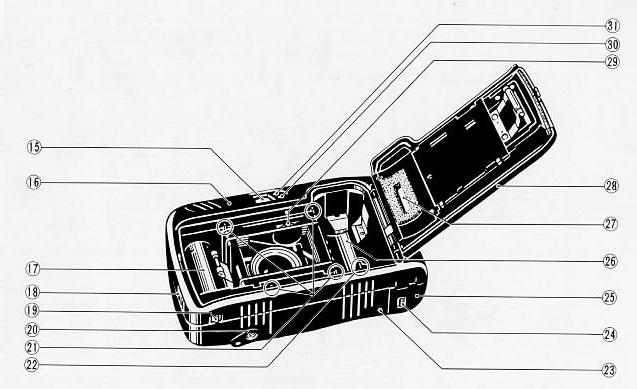
MAIN FEATURES
- light and compact with built-in ZOOM lens
- Safety Lock
- Super Night Mode
BEFORE USING
- This camera has a high voltage circuit. Because it is dangerous, DO NOT
ATTEMPT TO TAKE CAMERA APART
- Do not hold the lens part of the camera.
- Before taking important pictures (at weddings, on trips abroad, etc.) test
the camera to see how it works.
Images for figures 1- 64 and examples 1- 8
Click and print each individual page if needed
ATTACHING THE STRAP

1. Insert the small loop at the end of the Strap under the Strap Holder.
(Fig. 1)
2. Insert the other end of the Strap through the loop to tie the Strap onto
the Strap Holder. (Fig. 2)
INSERTING THE BATTERY
The camera will not operate unless the battery is installed. It is important
to make sure that the battery installed correctly.
1. Use a pen to push the Battery Compartment Cover Latch in the direction of
the arrow and pull open the cover.
(Fig. 3)
2. Insert the recommended 3 volt lithium battery, contact end first, checking
that the + and - on the battery are aligned according to polarity diagram inside
the battery compartment. (Fig. 4)
3. Close the Battery Compartment Cover by pushing it in the direction of the
arrow until it locks firmly in place. (Fig. 5)
* With the battery inserted correctly, the Battery Condition Mark ~ appears
on the LCD Panel when the Lens Shield is opened. (Fig. 6)
* Do not remove the battery from the camera until you are ready to replace
it.
* When replacing the battery, do so as quickly as possible to avoid erasing
camera memory. We recommend replacing the battery when there is no film in the
camera.
Recommended Replacement 3V Lithium Batteries
Include:
Lithium bakery (3V)
Panasonic CR-123A
Duracell XL DL-123A
OPENING THE VIEWFINDER COVER
1. Open the Lens Shield by sliding the Viewfinder Cover in the direction of
arrow. (Fig. 7)
2. When the Lens Shield is opened, the lens emerges from its standby position
to the ready position and the camera sets everything automatically.
* You can only take pictures when the Lens Shield is completely open.
* To avoid tripping the shutter inadvertently and wasting battery power,
always keep Viewfinder Cover closed when you are not taking pictures.
* When the Viewfinder Cover is closed, all LCD indicators will disappear to
conserve battery power.
CHECKING THE BATTERY
1. The ~D: symbol is displayed on the LCD Panel when battery power is
sufficient. (Fig. 8)
2. When the battery is nearly exhausted, the ~ symbol will appear. (Fig. 9)
Replace with a new battery as soon as possible. (Use of flash at this time is
not recommended.)
3. When the battery is completely exhausted, the G symbol will be displayed.
(Fig. 10) Replace with a new battery.
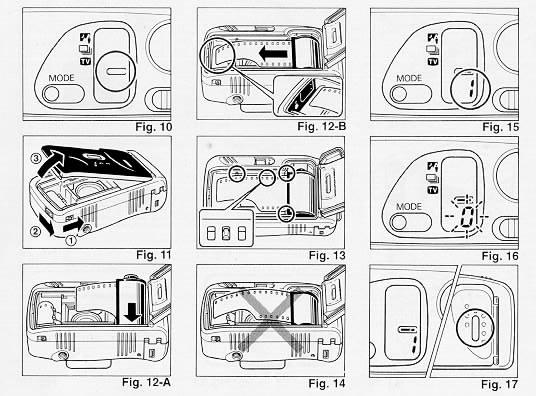
* In extremely cold temperatures, the battery mark may display the C symbol.
(In cold temperatures, the battery voltage is reduced.) You may be able to use
the camera if you remove the batteries and warm them up.
* If the battery voltage is insufficient, the shutter may not release or the
film may not advance completely. In the following cases, replace the battery:
1) When the battery mark displays the C symbol.
2) When the shutter does not release.
3) When film advance and rewind cannot be done. 4) When the self-timer does
not function.
LOADING THE FILM
Always avoid direct sunlight when loading the film.
1. Push the Back Cover Latch Downward to open.
* When the Safety Lock on the bottom of the camera is in the "on" position,
the back cover cannot be opened. Turn the lock to the "off" position to open the
back cover. (Fig. 11)
2. Load the film cassette into the Film Chamber and pull out enough film
leader to extend past the mark of the film leader position. (Figs. 12-A, 12-B)
* If there is any dust on the inside lens surface, use a blower to blow the
dust away.
3. Make sure the film stays within the Film Guides and lies flat. (Figs.
13,14)
4. Press the Back Cover shut so that the Back Cover Latch returns to its
original position. The film is automatically advanced until number "1" appears
in the LCD Panel. As soon as you close the Back Cover, the LCD Panel should
confirm proper loading with the Exposure Counter (Fig. 15)
5. If the film has not advanced correctly and is not taken up onto the Film
Take-up Spool, the Exposure Counter will blink. (Fig. 16) The shutter release
will also lock so you cannot take a picture until the film is loaded properly.
Reload the film by following steps 1 - 4 shown above.
* Whether there is film in your camera or not can be confirmed by either the
Film Loaded Window or the Exposure Counter in the LCD Panel. (Fig. 17)
* You can confirm that the film-wind or rewind is working properly by
observing the Exposure Counter.
* You can load film in your camera with the Lens Shield closed. However, the
loading sign will disappear after about 3 sec.
* Do not touch the inner lens with your fingers or the edge of film. (Fig.
18)
SETTING THE FILM SPEED

DX-coded film cassettes have black-and-silver patterns corresponding to film
speeds that the camera reads and automatically sets. Your camera accepts DX
films with speeds ranging from ISO 64 to 3200. Before loading your film, please
check whether the cassette is DX-encoded or not. (Fig. 19)
When using DX coded films, setting the film speed is not necessary. Your
camera automatically sets the correct film speed.
When using a film without DX code, your camera will automatically set itself
to ISO 100.
HOLDING YOUR CAMERA
1. Always use both hands to steady your camera. (Fig, 20)
* When holding the camera vertically always position it with the flash at the
top. (Fig. 21)
* Be careful not to place your fingers over the lens, flash or focusing
windows. (Fig. 22)
* We suggest that you become familiar with your new camera by shooting and
processing at least one roll of film before using your camera to record an
important occasion.
* If the camera moves during the exposure, the whole picture will be blurred.
To take clear pictures, hold the camera steadily and properly.
VIEWFINDER
(Fig. 23)
(1)
Field of View Frame:
The subject (such as people or scenery) you
wish to photograph should be set within this frame.
(2)
Parallax Correction Marks: (Close focusing)
When taking a picture
of a subject that is between 0.6 m -1.2 m away from your camera, the subject
should be positioned within these marks. Anything outside the marks will not be
included in the picture even if you can see it through the viewfinder
(3i)
AF Mark
in the AF mode the auto-focus system focuses
automatically on any subject that appears within this small [ ] target.
ZOOMING THE LENS
The built-in 38 - 60 mm zoom lens lets you get closer to your subject without
changing your position. This lets you easily select the composition that best
suits your subject.
(Examples 1, 2)
To zoom the lens, just slide the zoom
switch (Fig. 24) in either direction until your subject is framed properly.
* When zooming the lens, keep your fingers away from the moving lens
components.
* When closing the Viewfinder Cover, the lens will return to its storage
position automatically.
* After about 3 minutes, the lens will return to wide position and the
display on the LCD panel will disappear.
AUTO-FOCUS SHOOTING
1. Set the subject you wish to take within the Viewfinder Frame. (Fig. 25)
2. If the subject is closer than 0.6m the AF-Monitor will blink and the
shutter will lock to prevent out of focus pictures. (Fig. 26)
* Under certain unusual conditions, the AF Monitor may not warn when you are
too close to the subject.
3. Press the Shutter Release Button gently to avoid camera shake. The film
advances automatically after the shutter has been released.
* Be careful not to accidentally cover the Auto Focus Distance Measuring
Windows on the front of your camera, as this will cause incorrect focusing.
* Keep the Auto Focus Distance Measuring Windows clean to ensure accurate
focusing. If they get dirty, they should be wiped clean with a soft cloth.
* There may be rare cases when accurate focusing is difficult or impossible.
(For instance, with dark subjects that do not reflect light well, glossy
subjects, or subjects taken through glass.) In these cases, it is best to use
the Pre-Focus technique to "lock. the focus on a more ·normal. subject at the
same distance. While holding focus, turn your camera back to the nominal subject
and shoot. (See PREFOCUS SHOOTING (page 22) for more details.)
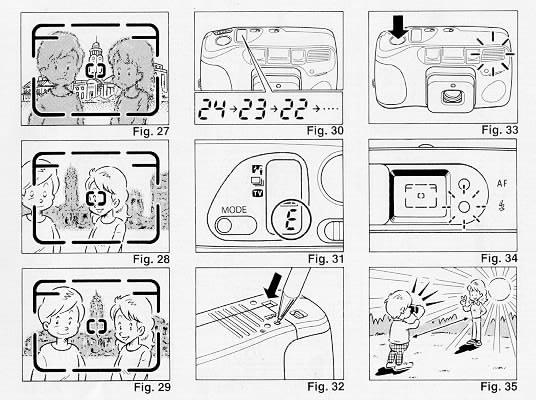
PRE-FOCUS SHOOTING
When the main subject you wish to focus on is not within the Auto-Focus
Frame, or if the subject is difficult to focus on, then you should use pre-focus
shooting.
When the subject is not within the Auto-Focus Frame: 1. If you want to
photograph two people, there may be cases where neither of them can be within
the Auto Focus Frame in the center of the Viewfinder. If you release the shutter
then, only the background will be in focus, and the people, who are the main
subject, will be out-of-focus. (Fig. 27)
2. Move the camera so that one of the people is within the Auto-Focus Frame.
Press the Shutter Release Button halfway so that the AF Monitor lights up.
Hold your finger in that position on the Shutter Release Button. (Fig. 28)
3. Now return the camera to its nominal position so that both people are in
the Field of View Frame again, and press the Shutter Release Button fully to
take the picture. (Fig. 29)
When the subject is difficult to focus on:
1. When you are photographing subjects that are difficult to focus on (such
as a black dog, glossy surface or behind glass), find another subject at about
the same distance from the camera. You can pre-focus on that subject in the same
way as described above.
* If you are shooting through a window, aiming the camera at a slight angle
to the glass usually avoids any direct reflection of auto-focus beam.
* When you remove your finger from the Shutter Release Button, the
pre-focused condition is cleared, so that you can pre-focus again as many times
as you wish.
REWINDING THE FILM (AUTO REVERSE)
1. After the end of the film has been reached, the film will automatically
rewind.
2. Film rewinding is indicated by the Exposure Counter and the counter
counting backwards. (Fig. 30)
3. When the film is fully rewound, the motor stops automatically and "E" is
displayed in the LCD Panel. (Fig. 31) Open the Back Cover to unload the film.
* When the Safety Lock is in the "one position, the Back Cover will not open
even if the Back Cover Latch is released. Move the Safety Lock to the ·off. to
remove your film.
* If you wish to rewind the film before reaching the end of the film, push
the Manual Film Rewind Button with a pen, etc. (Fig. 32)
* The shutter release is locked with "E" is displayed.
* Be careful not to touch the inner lens surface with your fingers or the
edge of film.
FLASH PHOTOGRAPHY
1. If additional light is required, the built-in Flash automatically
activates. (Fig. 33)
* Recommended Flash Shooting Range (ISO 100)
Wide angle: 0.8 m - about 4.2 m (2.6 ff. - 13.8 ft.) Telephoto: 0.6 m - about
3.0 m (2 ff. -10 ft.)
2. When the flash is still charging, the Red Flash Monitor will blink. (Fig.
34) Wait until RED-LED turns off in order to use the flash.
AUTO BACKLIGHT CONTROL/ AUTO FILL FLASH
When taking pictures of backlit subjects, important details are often lost
in the shadows. Your camera automatically compensates for these lighting
situations. If the subject is backlit and is at least about 3 meters from the
camera, Auto Back-Light Control (ABLC) will be activated. If the subject is
within about 3 meters of the camera, the flash activates automatically and the
shadows are lightened up using automatic daylight fill-flash. Thus, with backlit
subjects, natural-looking pictures can be taken easily and automatically. (Fig.
35)
USING THE SELF-TIMER
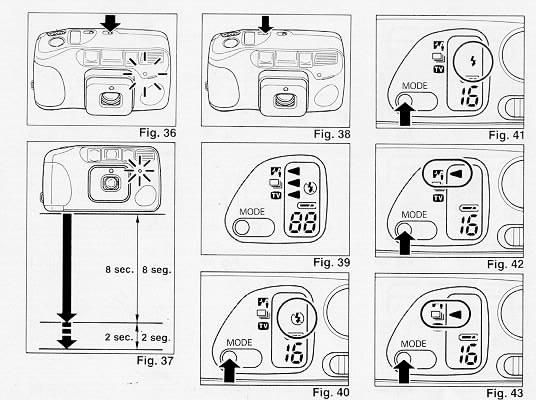
1. Compose your picture with the camera on a steady support.
2. Press Self-timer Button. The Self-timer LED on the front of the camera
will light steadily for approximately 8 seconds. Then the LED will blink for
about 2 seconds to indicate that the shutter is about to release. After a total
of about 10 seconds have elapsed, the shutter will release. (Figs. 36, 37)
* If you wish to stop the self-timer once it has started, close Viewfinder
Cover or press the Self-timer Button again.
Using the Self-timer for Flash Photography:
When the Self-timer Button is pressed the built in Flash will fire
automatically when ever there is insufficient light.
* You may not be able to activate the self-timer when the flash is just
beginning to recharge. Wait 2 - 3 seconds and try again.
* If the distance between subject and camera is too close, the AF Monitor
will blink. At that time, the self-timer will not activate. Move back a little
and try again.
* Too-Close Warning Lamp (AF Monitor) will blink only when pushing Self-timer
Button and/or the Shutter Release Button.
Using the Self-timer for Pre-focus Photography:
a. Select the subject you wish to pre-focus on. Move the camera so that it is
in Auto-Focus Target.
b. Press the Self-timer Button to lock-in the focus and reposition the camera
if necessary.
c. The self-timer activates and the focus will remain fixed at the locked-in
distance until the photograph is taken.
CREATIVE MODES
This camera includes a variety of special operating modes which permit you
to widely express your creativity. These modes include Flash-off, Flash-on, TV,
Continuous and Super Night.
Many combinations may be made using these selections with flash photography,
self-timer, and/or remote control picture taking, allowing you to fully and
precisely obtain the image you seek. Try experimenting. These modes are designed
to stimulate your imagination and creativity.
* To select operating modes, simply press the Mode Button next to the LCD
Panel located on the top of the camera. (Fig. 38)
You can confirm that the desired feature mode is in effect by checking the
LCD Panel with ~ which displays the current feature mode. The symbols used for
these modes are listed below. For detailed operation of each mode, refer to
their respective sections in this manual.
Feature Mode Symbols (Fig. 39)
· Flash-off
· Flash-on
· Super Night
·Continuous
FLASH-OFF MODE
This mode forcibly prevents automatic firing of the flash, thus allowing
available light photography in museums, churches, etc. where flash photography
is prohibited.
1. Press the Mode Button until the ~ symbol appears on the LCD Panel. (Fig.
40)
2. Press the Release Button and the shutter will be topped without flash.
* To cancel this mode, press the Mode Button until there is a different mode
symbol (or none) on the LCD Panel, or close the viewfinder cover.
* In dim light, the camera's shutter speed will be automatically reduced. To
prevent a blurry picture, hold the camera steadily and press the Shutter Release
Button gently.
FLASH-ON MODE
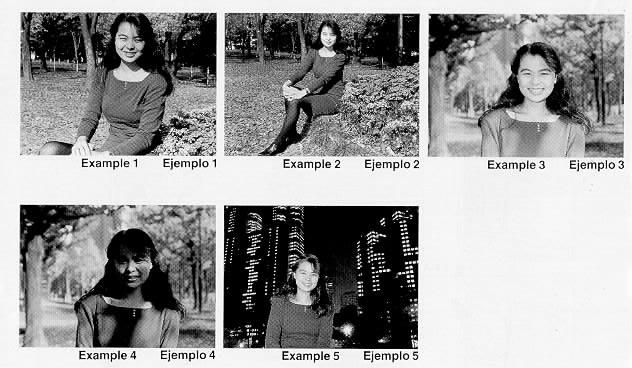
This forcibly trips the flash when you want to photograph subjects with
sunlight to their side or back. It lets you take more natural looking pictures
by softening harsh shadows.
Example
3:
When the Flash-on mode is set
Example
4:
When the Flash-on mode is not set
1. Press the Mode Button until the S symbol appears on the LCD Panel. (Fig.
41)
2. Press the Release Button. There will now be flash every time the shutter
is topped.
* The camera will follow a daytime SYNCHRO-Sunlight Exposure program in cases
of bright light.
* The camera will go to slow synchro photography in cases of dim light.
* To cancel this mode, press the Mode Button until there is a different mode
symbol (or none) on the LCD Panel, or close the viewfinder cover
SUPER NIGHT MODE
With the Super Night Mode, beautiful pictures can be easily taken at night.
The camera automatically selects the optimum settings for pictures of night
scenery, pictures of people at night (slow synchro photography), and evening or
day landscape pictures.
(Example
5)
1. When the Mode Button is pressed, ~ in the LCD Panel indicates the In.
mark. (Fig. 42)
2. To prevent the camera from moving, stabilize it with a tripod. Then,
gently press the Shutter Release Button to take a picture. When taking
pictures of night scenery with no subjects, the camera will focus on A. The
flash will not fire, and the shutter will open for one second (when there is no
object within 6 m). For taking photos of people against a background of
night scenery, the camera will first focus on ~ and open the shutter for 1
second without flash. After closing the shutter, the camera will then70cus on
the people and take another picture with the flash.
* By doing this, beautiful pictures of both the night scenery and people are
possible. (The people have to be within 6 m.)
* When taking pictures of landscapes in bright daylight, the camera will
focus on °° and set itself to auto exposure.
If people are taken in bright daylight, the camera will set itself to daytime
SYNCHRO-sunlight Exposure program which will set flash off.
Reference:
To prevent blurry pictures from slow shutter-speeds, we recommend using a
tripod and accessory cable release or remote electronic shutter.
CONTINUOUS SHOOTING MODE
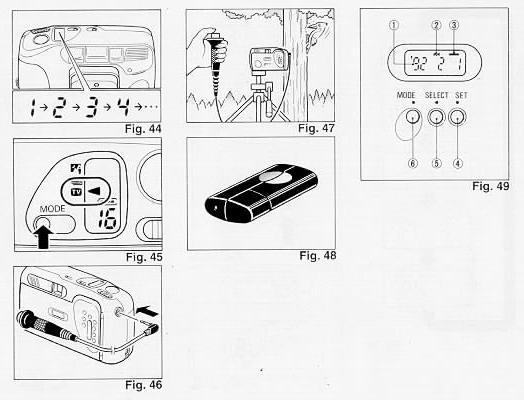
This mode allows you to shoot continuously as long as the shutter is
pressed.
You can accurately capture the continuous action such as competitive sport
events, moving subject and even the movements of an infant without missing any
important moments.
1. Press the Mode Button to set your camera in the Continuous Shooting Mode.
Confirm that the 1~, mark is indicated by ~ in the LCD Panel. (Fig. 43)
2. Press and hold down the Shutter Release Button. Your camera will
continuously take pictures at a rate of one frame per second as long as the
Shutter Release Button is held down. (Fig. 44)
3. Press the Mode Button to cancel the Continuous Shooting Mode.
* If you want to cancel the Continuous Shooting Mode before taking any
picture, press the Mode Button again until the mode marks go off, or close the
Viewfinder Cover
Combining the Continuous Shooting Mode and the Self-timer:
1. Set your camera to the Continuous Shooting Mode.
2. Press the Self-timer Button. Your camera will wait 10 seconds, then shoot
two sequential frames.
3. Push the Mode Button to cancel the Continuous Shooting Mode.
* Because the Auto-Focus adjusts with each exposure, be sure the subject is
in the Auto-Focus Target to ensure that the focus will not be on any other
object.
TV MODE
Use this mode to record your computer graphics or video images from the
screen of a computer monitor or television.
1. Press the Mode Button until the ~ mark is indicated by ~ in the LCD Panel.
(Fig. 45) Take the picture.
* The Flash Unit will not activate in the TV Mode.
* When taking pictures in the TV Mode, the shutter speed will be set between
1/30 sec. (wide) and 1/16 sec. (tale) and ISO will be reset to 100.
* For TV Mode photography, slow-moving TV images will usually turn out
clearer than fast-moving ones. Using a tripod and electronic cable release is
recommended to prevent camera shake.
* To use the self-timer in this mode, press the Mode Button until the camera
is set to TV Mode, then press the Self-timer Button.
* To cancel this mode, press the Mode Button until the LCD Panel shows a
different mode symbol (or none), or
close
Viewfinder Cover
ELECTRONIC REMOTE CONTROL SOCKET
This camera is equipped with an Electronic Remote Control Socket. You can
trip the shutter remotely in venous ways by plugging an (optional) infrared
sensor, remote controller, etc., into this socket. A 50 cm Electronic Cable
Release cord and a 10m extension cord are also available from Ricoh as options
for use in remote control photography.
Typical Installation
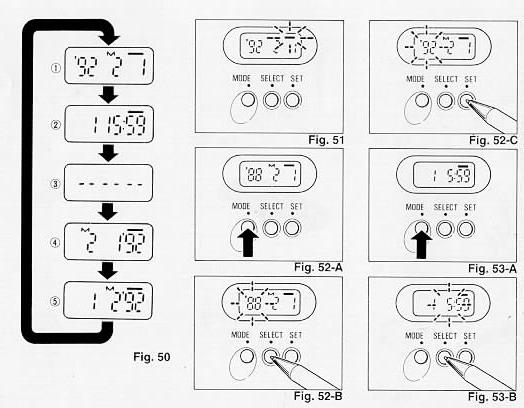
1. Insert the plug of the Electronic Cable Release or Remote Controller to
the Electronic Remote Control Socket. (Fig. 46) An extension cord can be used
for taking photographs at a distance from subjects.
2. Using a secure support, aim the camera at the subject and gently press the
remote controller button. (Fig. 47)
* Before inserting or pulling out a cord into/from this socket, close the
Lens Shield. If the Lens Shield is left open, the shutter might accidentally be
released.
Optional Wireless Remote Controller RC-10
The separately sold Wireless Remote Controller RC-10 allows you to easily
use remote control photography. (Fig, 48)
(OPTIONAL) DATABACK SETTINGS
Nomenclature of the date imprinting feature (Fig, 49)
(1) Display panel
(2) Month indication
(3) Imprint mark
(4) Set button
(5) Selector button
(6) Mode selector button
Imprinting mode
Examples of date imprinting (Fig. 50)
(1) 1992 February 1st
(2) 1st 15:59 (a) No imprinting
(3) February 1st, 1992
(4) 1st February, 1992
The date imprinting mode can be divided into 5 types: date, time, and no
imprinting.
Selecting imprinting mode
(Fig. 50)
Each time the Mode selector button is pressed, the display changes as shown
below.
(1) Date(Year/month/day)
(2) Time(Day/hour/minute)
(3) No imprinting
(4) Date(Month/day /year)
(5) Date(Day/month/year)
Checking imprinting
(Fig. 51)
After shooting, the imprint mark
--
flickers in
the display panel for a few seconds for correct imprinting. The mark and the
letter "M" are not imprinted on the picture.
Resetting the date and time (Figs. 52-A-C)
1. Each time the Selector button is pressed, the flashing digits change in
the order of year, month, day, hour, minute and colon (:).
2. When the digits to be reset flash, press the Set button until the desired
digits appear. When the Set button is kept pressed, the digits change rapidly.
Accurately setting seconds
(Figs. 53-A - C)
1. Press the Mode selector button for Time display mode.
2. Press the Selector button so that the colon (:) flickers.
3. Press the Set button according to the radio or telephone time signal. The
time count starts from 0 seconds.
* It is recommended that the second digits be adjusted after adjusting the
minute digits.
Battery Replacement
(Figs. 54-A, 54-B)
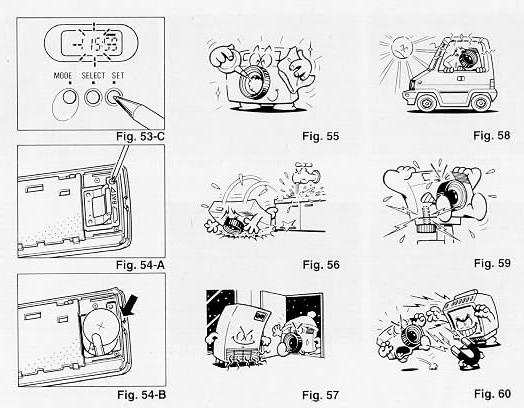
1. Open the back cover.
2. Remove the screw from the databack battery compartment cover with a small
(+) screwdriver
3. Remove the battery compartment cover holding the roller section, and lift
up the battery.
4. Load the new battery with the side marked (+) facing upwards. Then, close
the battery compartment cover using the (+) screwdriver. (Use lithium battery
CR2025. The service life is about 3 years.)
* When the battery is exhausted, the imprinted digits become faint. At that
time, replace the battery.
* Do not open the date battery compartment lid except when replacing the
battery.
* Keep the battery out of reach of children. If a child swallows the battery,
contact your doctor immediately.
Notes on date imprinting feature
* At temperatures below 0~C (32°F), the battery performance deteriorates. The
date imprinting feature may not function correctly and imprinting may become
impossible.
* When the battery is replaced, the display panel sometimes shows wrong
digits. Reset the digits for correct indication.
* The date is sometimes illegible if it is imprinted on the following
objects.
(1) ~Warm"-colored objects, such as red, yellow, orange, etc.
(2) Objects with details similar in size to the imprinted date (gravel,
leaves, etc.)
(3) Objects of high luminance (sky white wall, etc.)
* Imprinting is not possible in the following modes. (1) Print off mode
(2) Reset mode
(3) Battery check display mode (The display panel flashes.)
PROPER CARE OF YOUR CAMERA
* If there is dirt on the lens or Distance Measuring Windows and in the
camera body, do not attempt to remove it with your fingers. Use a blower to blow
the dust away, or wipe the surface gently with a soft cloth. (Fig. 55)
* Camera malfunction can be caused by shock, humidity, salt etc. After using
the camera at the beach or places where there is salt spray, high humidity or
chemicals, wipe it off carefully. (Fig. 56)
* Take care not to expose the camera to sudden changes in temperature, as
they may cause condensation on the lens and inside the body, or other
malfunctions. (Fig. 57)
* Do not expose the camera for a long period of time in extremely high
temperatures, such as in your car or on the beach, as this may ruin your film,
or cause other malfunctions. (Fig. 58)
* When using a tripod, do not try to force a long screw into the socket. The
screw length should be less than 5.7 mm. (Fig. 59)
* Do not place the camera near equipment that has strong magnetic fields such
as a television or radio. (Fig. 60)
MAJOR SPECIFICATIONS:
Type:
Full-automatic 35 mm autofocus lens-shutter camera with built-in
ZOOM lens.
Lens:
38 mm f4.5 - 60 mm f6.9 zoom lens 5 elements 5 groups
Focus:
Automatic focusing with pre-focusing facility.
0.6 m - °°/at telephoto 0.8 m - Cat wide angle
Self-timer:
Built-in electronic type with LED indicator. Operating delay
of approx. 10 sec.
Shutter:
Programmed AE type electronic shutter, 1/4 -1/300 sec.
Viewfinder:
Albada type with bright-frame zoom viewfinder
Exposure adjustment:
With CdS photocell. Programmed automatic exposure
adjustment with Automatic Backlight Control system.
Exposure coupling range EV6.3 -17 (wide), EV7.5 -18.2 (Tele)/lSO 100
Film speed range:
ISO 64 - 3200. Compatible with the DX code system.
(Non-DX films are set to ISO 100.)
Film loading:
Ricoh auto-load system
Film advance/rewind:
Automatic film advance and rewind, Automatic 1 st
frame setting, Automatic film rewind at the end of film.
Exposure counter:
Additive, counts down during film rewind.
Built-in flash:
Electronic flash automatically activates in dim light
and backlight.
Flash range:
0.8 m - 4.2 m (2.6 H. -13.8 ft.) (at wide-angle),
0.6 m - 3.0 m (2 R. -10 ft.) (at telephoto) (ISO 100)
Interval between flashed About 6 sec.
Other features:
Flash-on, Flash-off, Super Night Mode, TV Mode,
Continuous Mode, Safety Lock, Electronic Remote Control Socket, Tripod Socket
Power Source:
3V lithium battery (CR-1 23A, DL-1 23A) or equivalent
Dimensions:
119.2 mm/4.7 in. (w) x 66.5 mm/2.6 in. (h) x 40 mm/1.6 in.
(d)
Weight:
230 9 (8.10 oz.) (without battery)
* Specifications are subject to change without notice.











